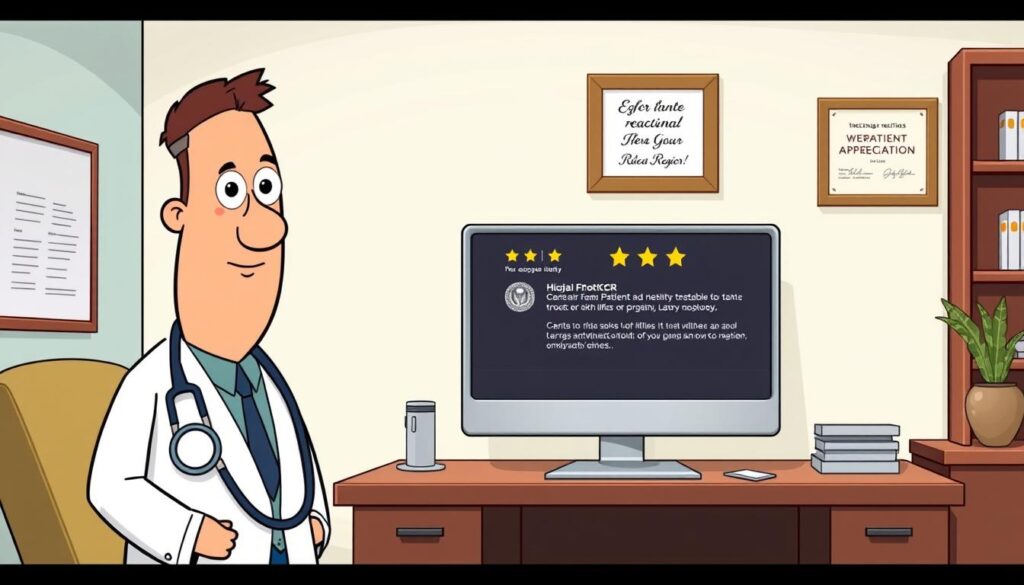Did you know that 72% of patients now look online for health info? This shift is changing how doctors market themselves. To grow your practice, having a strong online presence is now a must. In today’s digital world, marketing for doctors is key for drawing in new patients and keeping current ones happy.
Understanding your audience and using digital tools is now crucial. Social media, for example, plays a big role, with 41% of patients choosing facilities based on it, according to PwC. Also, making your website easy to find online is important.
This article will explore effective marketing strategies for doctors. By using digital marketing well, you can attract more patients and keep them engaged. For more tips on boosting your practice, check out Revenue Boomers for expert advice.
Key Takeaways
- Building an online presence is vital as most patients seek information digitally.
- Social media engagement is significant for influencing patient decisions.
- Email marketing is highly effective, with patients preferring direct communication.
- Creating educational content establishes authority and builds trust among patients.
- Utilizing local SEO strategies can attract nearby patients to your practice.
- Patient feedback and online reviews are crucial for reputation management.
Understanding the Importance of Marketing for Doctors
Medical marketing is crucial in today’s healthcare world. It needs a special approach because of the sensitive nature of health care. Trust and credibility are key. Good marketing helps doctors get more patients, improve communication, and build a strong reputation in their communities.
What Makes Medical Marketing Unique?
Healthcare marketing has changed a lot over time. It used to focus on building a big image. Now, it’s all about delivering services and focusing on patients. This shift shows the industry’s move towards personalized care.
Doctors are now using new technologies and data to build strong patient relationships. This approach is all about understanding and meeting individual patient needs.
Benefits of Effective Marketing Strategies
Good marketing strategies help doctors in many ways:
- Increased Visibility: New marketing methods help doctors stand out in a busy market.
- Enhanced Patient Relationships: By matching services with what patients want, doctors keep patients coming back.
- Better Communication: Modern marketing helps doctors talk better with patients, making everyone happier.
- Data Utilization: Using market data helps doctors tailor their marketing to what patients really need.
- Competitive Advantage: A strong online presence through SEO and social media makes doctors more competitive.
| Aspect | Traditional Marketing | Medical Marketing Today |
|---|---|---|
| Focus | Image-oriented | Service-oriented |
| Approach | Mass Marketing | Personalized Marketing |
| Patient Engagement | Low Engagement | High Engagement |
| Technology Utilization | Low-Tech | High-Tech |
| Relationship Building | Transactional | Relational |
Defining Your Target Audience
Understanding your target audience is key for good healthcare content marketing. Knowing who your patients are helps tailor your marketing. A clear target audience boosts engagement and patient happiness. You need to look at things like where they live, who they are, and what they like to do.
Identifying Patient Demographics
Starting with a clear picture of who might be interested in your services is crucial. For example, you might focus on married couples aged 21 to 35, living in certain areas, and making over $65,000 a year. They are often young families who care about their health but are also busy.
Using data from places like the U.S. Census Bureau can give you the information you need. This helps you understand your potential patients better.
Understanding Patient Needs and Preferences
Knowing what your audience likes and needs is also important. Most people in this group look for health info online. They want to save time and stay healthy, so your messages should match their fast-paced lives.
Using digital platforms and making your website easy to use on phones is a good idea. This way, you can reach almost everyone who uses a smartphone. Making your services fit their needs can make them more loyal to your practice.

Building a Professional Website
A professional website is key for a medical practice’s success. It’s not just a place for info. It’s also a tool to connect with patients and improve their experience.
Essential Features of a Medical Website
Creating a good healthcare website needs some important features. These features make the site easy to use and engaging. Key elements include:
- Responsive Design: This makes sure the site works well on phones, since many people search for health info on their phones.
- Secure Online Appointments: This lets patients book appointments easily, helping to attract more patients.
- Comprehensive Content: Good content about services helps with SEO, making the site more visible online.
- Contact Information: Having this info in the header and footer makes it easy for patients to get in touch.
- Local SEO Strategies: Using local keywords and a Google Business Profile helps the site show up more in local searches.
Optimizing for User Experience
Making a site easy to use can really help a practice’s online image. Good medical SEO can bring in more visitors and patients. Here are some ways to improve:
- On-page Optimization: Use the right keywords in your content to rank higher in search results.
- Off-page Optimization: Get links from trusted sites to make your site more credible.
- Consistent NAP: Keep your Name, Address, and Phone number the same everywhere to ensure people can find you easily.
- Engagement Techniques: Use videos and patient stories to build trust and keep visitors interested, making your site a valuable resource.
Utilizing Social Media for Your Practice
Social media is key for doctor branding today. It helps doctors connect with patients. Sites like Facebook, Instagram, and LinkedIn let doctors share their skills and services. This boosts visibility and builds trust with the community.
Best Platforms for Medical Professionals
Picking the right platforms is crucial for doctors. Each one targets different people and goals:
| Platform | Demographics | Best Use |
|---|---|---|
| Wide age range, high engagement | Sharing updates, patient testimonials | |
| Younger audience, visual content | Health tips, practice achievements | |
| Professionals and peers | Networking, partnerships |
Creating Engaging Content
Posting interesting and useful content is key. It helps build strong patient relationships. Doctors should share:
- Informative health tips to educate followers.
- Patient success stories to show off treatments.
- Practice updates to keep followers engaged.
Using analytics helps doctors see what their audience likes. Posting regularly keeps followers interested. For more tips, check out this resource.

Content Marketing Strategies for Doctors
Effective content marketing is key for healthcare practices. Doctors can become authorities by sharing educational content. This approach includes written articles and videos.
Educational Blogs and Articles
Blog posts boost visibility and build patient relationships. Blogging can lead to a 13 times better return on investment. Topics like “Partner with Trusted Health Care Workers” grab attention.
Adding patient testimonials makes content more relatable. Infographics also help keep readers interested by simplifying complex info.
Video Content and Webinars
Video marketing is crucial in healthcare. 88% of doctors prefer video learning over text. Educational videos increase engagement.
Webinars and live Q&A sessions answer questions and build community. 55.8% of doctors like webinars for learning. Videos humanize brands and connect with audiences.
Podcasts offer a variety of medical topics. They keep listeners informed and engaged.

Search Engine Optimization (SEO) Essentials
SEO is key for medical practices wanting to be seen online and get more patients. Good SEO strategies make marketing work better. Since many patients search locally for healthcare, knowing how to use SEO is vital.
Why SEO Matters for Health Services
Good SEO means your practice shows up higher in search results. This makes it easier for patients to find you. It also builds trust and authority, which are important for getting patients.
SEO helps manage your online presence. It shows your practice’s location, which is key for attracting patients.
Keyword Research Tips for Medical Websites
Keyword research is the base of SEO success. Finding the right keywords helps make your website content better. Tools like Ubersuggest and LSIGraph help with keyword research for local SEO.
Using specific keywords can help your practice show up in Google’s “3 Pack.” This makes you more visible in local searches.

| SEO Strategy | Description | Benefits |
|---|---|---|
| Local SEO | Optimize practice for local searches, including GMB listings. | Higher visibility in local searches and increased foot traffic. |
| Keyword Research | Identify and implement relevant search terms in content. | Improved search rankings and targeted traffic. |
| Quality Content | Create informative and engaging content tailored to patient needs. | Enhanced engagement and authority in the field. |
| Patient Reviews | Encourage positive reviews on various platforms. | Influences potential patients’ decisions and improves rankings. |
| Video Content | Incorporate videos to enhance engagement and trust. | Increased on-page time and better SEO performance. |
Online Reviews and Reputation Management
In today’s digital world, patient feedback is key. Online reviews shape a healthcare practice’s reputation. With 81% of patients checking reviews before choosing a doctor, managing your reputation online is crucial. A good online image builds trust and attracts more patients. But, bad reviews or none at all can scare off potential patients.
Importance of Patient Feedback
More than 80% of patients look at Google reviews when picking a doctor. A whopping 83% pay close attention to what others say. Practices with 4.5 to 4.9 ratings get the most benefits. This shows why managing your online image is vital.
How to Encourage Positive Reviews
To improve your reputation, try these strategies:
- Ask patients for reviews after their visits.
- Send reminders to get feedback.
- Quickly address any negative feedback.
- Rank high on Google and Yelp.
- Show off good reviews on your website.
Engage with patients through different ways. Use an iPad in the lobby, text or email for reviews. It’s important to get detailed feedback, not just short comments.

Online reviews deeply affect medical practices. With the right management, you can greatly improve your reputation. Also, responding to negative reviews is key to keeping a good image. This means watching review sites and creating a place where feedback is valued.
Email Marketing for Patient Engagement
Email marketing is key for engaging patients. It helps medical practices build strong connections and share important updates. Newsletters are a big part of this, keeping patients informed about practice news and health tips.
Crafting Effective Newsletters
Newsletters need to be interesting and full of useful info. They should mix articles, events, promotions, and success stories. Aim for 70% free content and 30% promotions. Sending them weekly helps keep patients engaged.
Healthcare newsletters see open rates around 19%. Specialized fields like cardiology can reach up to 31%.
Segmenting Your Audience for Better Results
Segmenting patients by demographics and interests makes emails more effective. Tailored messages boost open rates and engagement. This way, practices send content that matters to each patient, reducing the chance of them unsubscribing.
Using an automated email suppression list keeps your list clean. Investing in email software helps track important metrics like click rates and list growth.
Using email marketing for patient engagement can also attract new patients. Clinics that do this well see big improvements, like an 11% increase in engagement over five months.
Leveraging Local SEO for Visibility
Local SEO is key to attracting patients from nearby. Medical practices face competition from local and big healthcare networks. To shine, make your Google Business Profile pop in local searches. A strong online presence helps people find your services when they need medical help nearby.
Optimizing Google My Business
An up-to-date Google Business Profile is crucial for marketing. It should have your name, address, and hours. Photos of your facilities can grab attention. Keeping this info fresh builds trust.
Local Listings and Directories
Being in local directories is vital for SEO. These make it easy for people to find medical services near them. Having the same NAP (name, address, phone number) everywhere boosts credibility and search rankings.
| Directory Name | Key Features | Benefits |
|---|---|---|
| Healthgrades | Patient reviews, appointment scheduling | Enhances visibility, builds trust |
| Zocdoc | Online booking, patient ratings | Convenient for patients, attracts new clientele |
| WebMD’s Physician Directory | High domain authority, educational content | Amplifies reach, improves credibility |
| RateMDs | Patient testimonials, care quality ratings | Validates quality of care, boosts local SEO |
| Vitals | Patient reviews, doctor credentials | Increases patient engagement, enhances visibility |
Make sure your practice’s info is the same everywhere online. This boosts local visibility and your online presence. Interacting with patients through reviews and updates helps your SEO. For more on local SEO in healthcare, check out these strategies.
Paid Advertising Strategies
In today’s competitive healthcare world, paid ads can really help medical practices stand out. Doctors can use online platforms to reach more people. This way, they can make sure their services are found by those who need them.
Using PPC ads is a smart move. It brings in more visitors and lets doctors tailor their ads to fit certain groups.
Understanding PPC and Google Ads
Google Ads is a big deal for doctors’ ads. It helps them show up first in search results, which is key since most people don’t look beyond the first page. The pay-per-click model means doctors only pay when someone clicks on their ad. This makes it a cost-effective choice.
Small medical businesses might spend $3,000 to $15,000 a month on these ads. On average, doctors in the USA spend about $6,677 each month.
Google Ads also tracks who’s looking at ads, from the first search to making contact. Doctors can target ads by age, location, and medical needs. This makes ads more effective. PPC ads can quickly show results, often in just 2 to 4 weeks.
Facebook Advertising for Medical Practices
Facebook is also a big player in doctor ads. It lets doctors make ads for specific groups. This helps build brand awareness and connect with patients. Facebook ads can also reach people who showed interest but didn’t book an appointment.
Using both Google Ads and Facebook ads is a smart strategy. Google Ads get more conversions, while Facebook ads help with brand awareness. Together, they help doctors attract new patients.
| Practice Type | Average Monthly Advertising Budget |
|---|---|
| Medspa and Plastic Surgeons | $6,677 |
| Urgent Care Clinics | $2,600 |
| Primary Care Doctors | $890 |
| Pediatric Practices | $900 |
| Sexual Health Practices | $4,200 |
| Optometrists and Ophthalmologists | $750 |
For the best results, add a strong SEO plan to your paid ads. This can really grow your practice. Keep an eye on your ads and make changes as needed. This way, your ads will keep bringing in new patients. For more tips on improving your online presence, check out this article on medical SEO effectiveness.
Networking and Community Involvement
Building connections in healthcare and the community is key for any medical practice. Good networking can bring in new patients and make your practice known in the area. Working with other healthcare providers builds trust and support. It’s good for everyone.
Being active in community events shows you care about public health. This helps build strong relationships with your patients.
Building Relationships with Other Healthcare Providers
Forming alliances with other healthcare providers can really help your practice. These partnerships often lead to referrals, where providers recommend each other. A strong network can include:
- Regular meetings with local specialists.
- Participation in professional associations.
- Engagement in local health initiatives.
These partnerships improve patient care and help your practice grow.
Participating in Local Health Events
Getting involved in local health fairs and wellness events can boost your practice’s visibility. These events let you meet potential patients and share health tips. Ways to make the most of these events include:
- Setting up booths to showcase your services.
- Providing free health screenings or consultations.
- Distributing brochures and marketing materials.
Also, using online platforms to promote events can reach more people. Most patients start their healthcare journey online. So, it’s important to be easy to find and learn about. Effective marketing strategies can help with this.
| Event Type | Benefits |
|---|---|
| Health Fairs | Direct patient engagement and education. |
| Workshops | Demonstration of expertise; patient trust. |
| Community Sponsorships | Increased visibility and brand loyalty. |
By focusing on networking and community involvement, your practice can become a trusted resource. This will improve patient loyalty and satisfaction.
Measuring Marketing Success
It’s crucial to know how to check if your marketing is working well. By watching important numbers, you can see if your plans are paying off. Key areas to look at include website visits, how much it costs to get new patients, and where new patients come from.
Also, checking social media can show if your online messages are hitting the mark with potential patients.
Key Metrics to Track
Keeping an eye on different marketing numbers helps you see how your campaigns are doing. For example, seeing how many people book online shows if your website is working. Also, looking at how often patients come back and how they interact with your social media helps understand their happiness and loyalty.
Remember, it often takes several ads to get a new patient. This shows the importance of using many marketing ways to reach people.
Tools for Analyzing Performance
Tools like Google Analytics help you see important data about your marketing. You can look at how many new versus returning patients you have, or why people might leave your site. By checking this info often, you can make better choices and tweak your plans.
By regularly checking your marketing numbers over a year, you can make your marketing more effective. This can help your practice grow and stay strong in the market.






